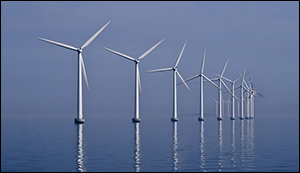UK approves world's biggest offshore wind farm project
17. 8. 2016 | Phys.org | phys.org
The British government gave the green light for what it called the world's biggest offshore wind farm to be built off the English coast.
The Hornsea Project Two farm should have up to 300 turbines and a capacity of up to 1.8 gigawatts. It could produce enough energy to power 1.6 million homes. It is an extension of the 1.2GW Hornsea Project One which was in itself being trumpeted as the world's biggest offshore wind farm.

Both projects are being developed by Danish group DONG Energy, the world's largest operator of offshore wind farms. London decided to grant development consent for Hornsea Project Two, located around 55 miles (90 kilometres) east of the English coast.
If built to full capacity, the Hornsea Project Two investment would total around £6 billion ($7.8 billion, 6.9 billion euros). The farm would create up to 1,960 construction jobs and 580 operational and maintenance jobs, the government said. The government said it expected 10GW of offshore wind to be installed by the end of the decade and a further 10GW of offshore wind capacity could be built in the 2020s.
Read more at Phys.org
Image Credit: Wikipedia
-jk-




